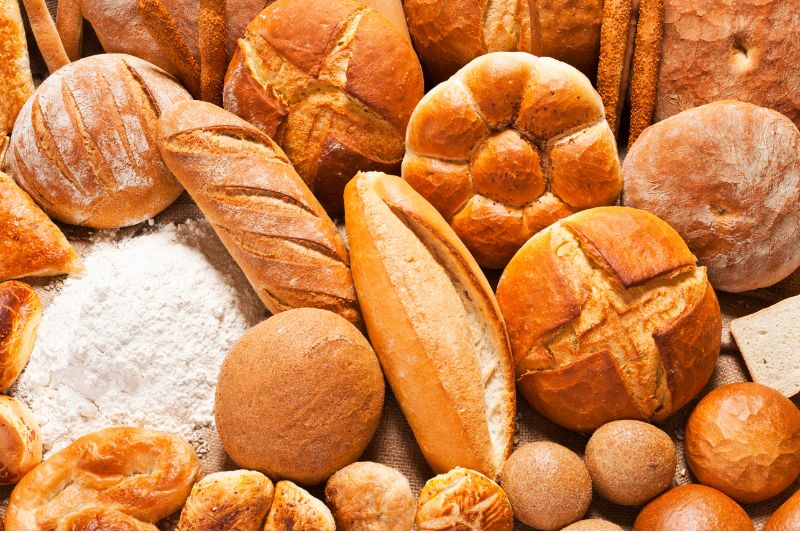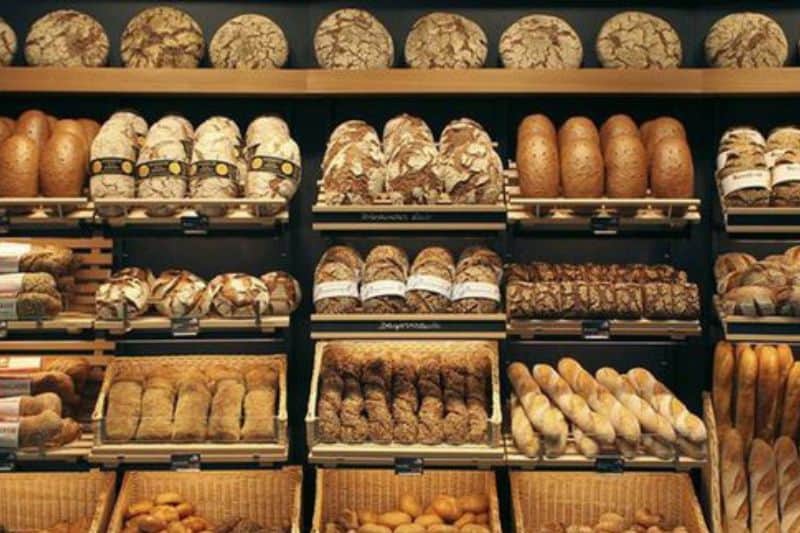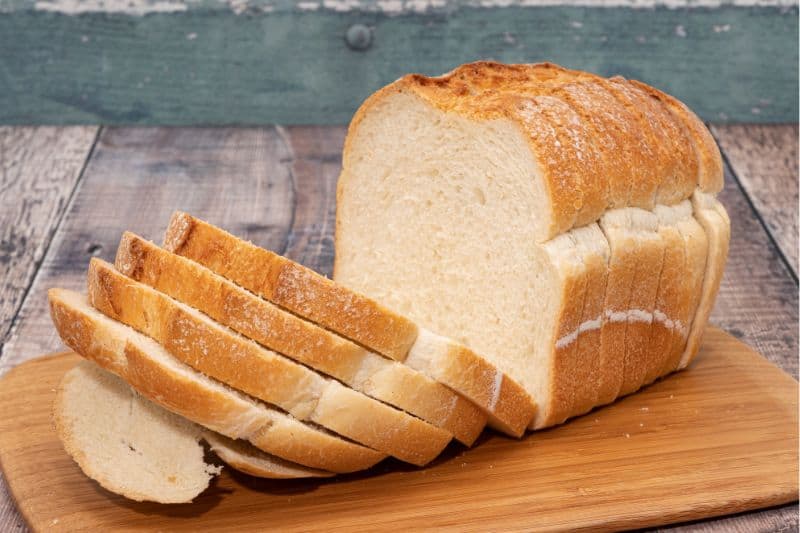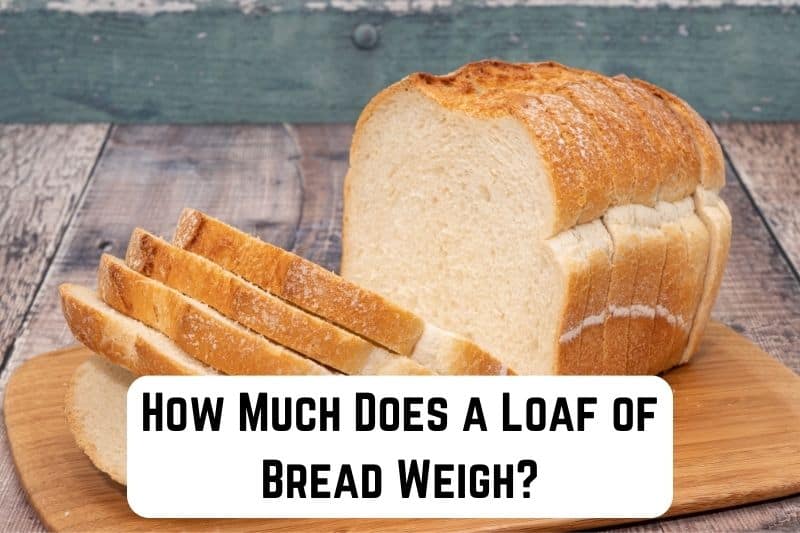As I stroll through the supermarket aisles, I can’t help but notice the wide variety of breads available. From artisanal sourdough to soft sandwich bread, there’s something for every taste and occasion.
But have you ever stopped to think about how much a loaf of bread weighs? This seemingly trivial question might have crossed your mind, and interestingly, the answer isn’t as simple as it may seem.
Let’s explore what makes bread heavy. This will help you make better decisions when buying bread. Let’s start this delicious journey!

Read: How Much Does a Hammer Weigh? (Around 16 Ounces)
A typical white or whole wheat bread loaf may weigh between 16-24 ounces (450-680 grams). In contrast, more artisanal bread like sourdough or rye bread could be slightly heavier, weighing around 32 ounces (900 grams).
Understanding the Weight of a Loaf of Bread
I’ve always found it fascinating that there is quite a range in the weight of a loaf of bread. Various factors can influence the weight, including the type of bread, the size, and the ingredients used. Let’s dive into these different factors that can impact the weight of bread and explore some examples.
Firstly, the type of bread plays a significant role in determining the weight of a loaf. Some bread types are denser, while others are lighter and fluffier.
For instance, a typical white or whole wheat bread loaf may weigh between 16-24 ounces (450-680 grams). In contrast, more artisanal bread like sourdough or rye bread could be slightly heavier, weighing around 32 ounces (900 grams).
Secondly, the size of the loaf is another crucial consideration. Bread can be found in various shapes and sizes, including small dinner rolls, medium-sized sandwich loaves, and large boules.
A small dinner roll might weigh approximately 1-2 ounces (30-60 grams), while a medium-sized sandwich loaf could range from 16 to 24 ounces (450-680 grams).
Lastly, the ingredients used in making the bread can also impact the weight. Some loaves contain nuts, seeds, or dried fruits, which can contribute to their heaviness.
Certain types of flour or sweeteners can also affect the final weight of a loaf. For example, a loaf of bread made with whole-grain flour might be denser and slightly heavier than one made with refined white flour.
Factors Influencing Bread Weight
When I look at the different factors affecting the weight of a loaf of bread, I usually consider three key components: Size, Type of Bread, and Ingredients Used.

Size
First and foremost, the weight of a bread loaf is significantly impacted by its size. Small loaves, often called mini loaves or demi-baguettes, typically weigh less than larger sandwiches or artisan breads. Here are some standard sizes and their usual weights:
- Mini loaf: 3-4 ounces (85-113 grams)
- Baguette: 8-9 ounces (226-255 grams)
- Sandwich loaf: 16-24 ounces (453-680 grams)
- Artisan loaf: 24-32 ounces (680-907 grams)
Different recipes and bakers may have unique sizes, but these are general guidelines that I find helpful.
Type of Bread
The type of bread can also significantly impact the weight of a loaf. There are countless bread varieties, ranging from light and airy ciabatta to dense, chewy rye bread. Here are a few examples:
- Ciabatta: This Italian bread is known for its light and porous texture, which means it will generally weigh less than other types of bread of a similar size.
- Sourdough: Sourdough bread has a dense texture, but its weight can vary depending on the recipe and fermentation process.
- Rye Bread: Typically, rye bread weighs more than other types of bread because of its dense texture and the heavy rye flour used in its production.
Ingredients Used

Another essential element that influences the weight of a loaf of bread is the ingredients used. Certain components can add more heft to the final product, while others can make it lighter. Here are a few examples:
- Flour: Different types of flour, such as whole wheat, white, or rye, can affect the weight of the bread. Whole grain flour tends to create denser, heavier loaves.
- Fats: Adding fats like butter or oil can increase the weight of a loaf.
- Water content: A dough with a high water content will typically produce a lighter, more airy bread, while a dough with less water will result in a denser, heavier loaf.
Industry Standards for Bread Weight
When I think about how much a loaf of bread weighs, I consider that industry standards are in place to ensure consistency. Generally, bread comes in a few standard sizes, which may vary depending on the type of bread or the region you are in.
Aside from the size of the loaf, the type of bread can also affect its weight. Denser breads, such as rye or pumpernickel, will usually weigh more compared to their volume than lighter breads like white or sourdough.
Specialty breads, like baguettes, ciabatta, or challah, also come in various weights and sizes, adding to the diversity of what’s available on the market.
I’d also like to mention that artisan breads from bakeries might not always adhere to the same industry standards as commercial breads in grocery stores.
Variations in Bread Weight Around the World
European Bread Weight
In my travels across Europe, I’ve found that bread weights can vary significantly from one country to another.

For example, French baguettes typically weigh around 250 grams, while their Italian counterpart, the ciabatta, can weigh up to 300 grams. In Germany, a dense and hearty loaf of bread, like pumpernickel, can weigh more than 500 grams. Here are some typical bread weights found in European countries:
- French baguette: 250g
- Italian ciabatta: 300g
- German pumpernickel: 500g+
As you can see, there’s a wide variety of bread weights in Europe!
American Bread Weight
In America, the bread market consists mainly of pre-sliced loaves that come in standardized sizes and weights.

You will often find loaves weighing around 1 pound (approximately 454 grams) and 1.5 pounds (about 680 grams). Here are some proper American bread weight measurements:
- Pre-sliced sandwich bread: 1 pound (454g)
- Large loaf of sourdough: 1.5 pounds (680g)
Homemade Bread Vs. Store-Bought Bread

Weight Differences
When I bake bread at home, I’ve noticed that my homemade loaf tends to be slightly heavier than the store-bought ones. Typically, a standard loaf of store-bought bread weighs around 1 to 1.5 pounds (450 to 680 grams).
In contrast, my homemade bread usually weighs between 1.5 to 2 pounds (680 to 907 grams). However, this can vary based on the ingredients I use and the size of the loaf.
Read: How Much Does a Lemon Weigh? (3 – 6 Ounces)
Reasons for Differences
I’ve found that there are several factors contributing to the weight differences between homemade and store-bought bread:
- Ingredient ratios: Homemade bread recipes might call for more flour or denser ingredients, creating a heavier loaf.
- Baking process: Store-bought bread is typically mass-produced, and manufacturers may use specific methods to create a light and airy texture. On the other hand, home bakers like myself may not be able to replicate these same methods, which could result in a slightly denser loaf.
- Size and shape: Store-bought bread is often machine-molded, so it has a uniform size and shape that yields a consistent weight. Homemade loaves, however, can be shaped by hand and might result in various sizes and shapes, affecting the overall weight.

It’s important to remember that these differences don’t necessarily indicate a quality difference between the two types of bread. The taste, texture, and nutritional content of homemade and store-bought loaves can be similar, but their weights and shapes might differ for various reasons.
Frequently Asked Questions
What is the weight of a typical loaf of bread in grams?
A typical loaf of bread weighs about 500 grams, but this can vary depending on the type and size of the bread. Some artisan loaves or denser bread types like rye or whole wheat might weigh more, while lighter breads like baguettes could weigh less.
How many ounces are in a regular loaf of bread?
In a regular loaf of bread, which typically weighs around 500 grams, there are roughly 17.6 ounces. Remember that different types of bread can have varying weights, so it’s best to check the packaging for the specific weight if you need a more accurate measurement.
What is the weight of a loaf of bread in pounds?
Bread usually weighs between 1 to 2 pounds, depending on its type and size. A 500-gram loaf of bread is approximately 1.1 pounds. Whole wheat or rye bread may weigh closer to 2 pounds. Check the packaging or consult with a baker for more specific information.







